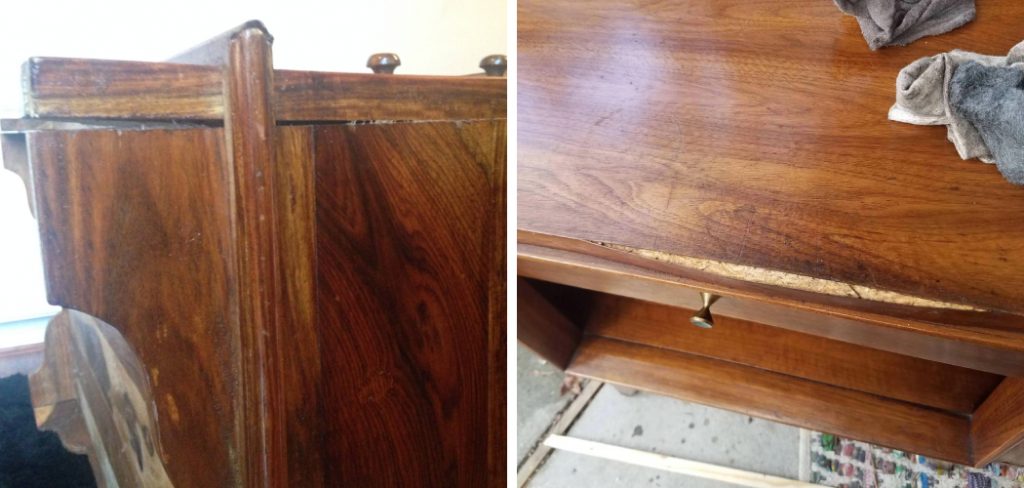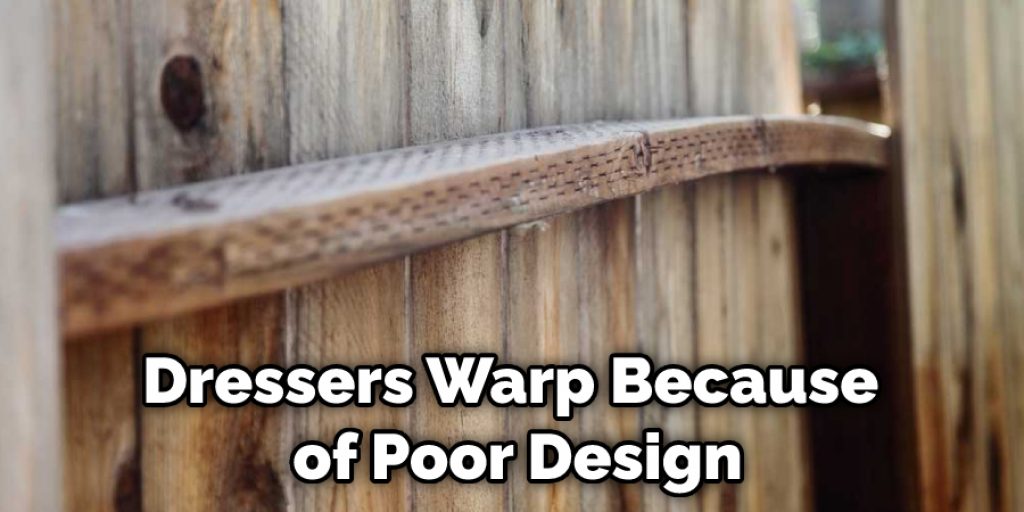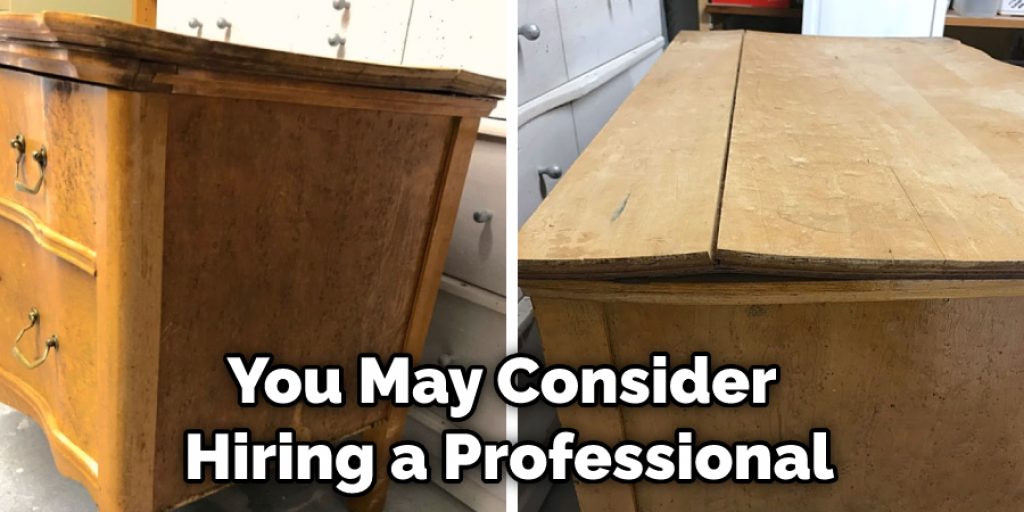Warped wood dressers are a pain to deal with. But before you throw it out or call a professional, there are a few things you can try to fix it yourself. You can get your warped dresser back in working order with a little time and effort. Check out our step-by-step guide below on how to fix warped wood dresser.

Wooden dressers are a popular piece of furniture in many homes. While they are often sturdy and long-lasting, they can also be susceptible to warping over time. If your dresser has warped, don’t worry; there is a way to fix it! In this blog post, we will discuss what causes wood warping and how to correct it. We will also provide tips for preventing your dresser from warping in the future. Read on for all the details!
Summary: Repairing warped wood dresser drawers can be tricky, but here are some tips to get you started. Begin by removing all of the hardware from the dresser, including screws and hinges. Inspect the drawers for any splits or cracks, and use a putty knife to fill in any gaps.
Securely attach a weighted object to the center of the drawer with brackets if necessary. If there is still significant warping, place shims between the dresser body and the drawers to prop up those parts of the drawer that are higher than other sections.
10 Reasons That Causes Wood Wrap
1. Poor Quality Of Wood:
Some woods are just naturally bad at holding up to moisture. They warp and twist easily, and there’s not much you can do about it. If you have a low-quality wood dresser, it’s likely to warp over time, no matter what you do.
2. Humidity Levels:
If the humidity levels in your home are too high, your wood dresser will warp. The moisture in the air will make the wood swell and bend. If you live in a humid climate or your home is particularly damp, you’re going to need to take steps to reduce the humidity. You can do this by using a dehumidifier, opening windows when it’s not too humid outside, and ventilating your home. You should also make sure that you’re not over-watering your plants, as this can add to the humidity in your home.
You can keep your dresser’s room free of humidity by running a dehumidifier and ensuring proper ventilation. Additionally, make sure the dresser isn’t too close to a radiator or other heat source.
3. Temperature Changes:
The same way that high humidity levels can cause your wood dresser to warp, temperature changes can also have the same effect. If the weather is hot and humid, your dresser will absorb that moisture and swell.
As the temperature cools down, the dresser will contract and warp. These changes can happen even if you don’t live in a particularly humid climate. For example, if your home is heated with a radiator or baseboard heaters, they can cause the air in the room to be drier than usual, which will cause the dresser to shrink and warp.
4. Damaged By Insects:
Certain insects, like termites and carpenter ants, can cause wood to warp. These insects burrow into the wood and create tunnels. This weakens the wood and makes it more susceptible to warping. You can usually tell if your dresser has been damaged by insects if you see small holes in the wood or if the wood is abnormally soft.
5. Excessive Use:

If you use your dresser a lot. This is because the constant use puts a lot of stress on the wood. The more you use it, the more likely it is to warp.
6. Poorly-Fitted Pieces:
If your dresser is made up of poorly-fitted pieces, it’s likely to warp over time. This is because the joints won’t be as strong as if the pieces were fitted together properly. As a result, when the dresser is subjected to stress, the joints will give way and the dresser will warp.
7. Age of the Wood:
As wood ages, it becomes more brittle and is more likely to warp. So if your dresser is made of an older type of wood, it’s more likely to warp than a dresser made of newer, stronger wood.
8. Excessive Moisture:
If your dresser is constantly exposed to excessive moisture, it will warp. This could be due to a leaky roof, a plumbing leak, or even putting your wet laundry on the dresser. If your dresser is constantly exposed to moisture, you need to take steps to protect it.
9. Not Enough Support:
If your dresser isn’t properly supported, it’s going to warp. This is because the dresser’s weight will cause it to sag in the middle of it doesn’t have enough support. So make sure that your dresser is sitting on a level surface and has enough support in the middle.
10. Poor Design:
Sometimes, dressers warp because of poor design. For example, if the pieces of wood are not cut correctly or if the joints are not fitted well, the dresser will warp. This is more likely to happen with cheaper, mass-produced dressers. If you have a high-quality dresser that’s been well-made, it’s less likely to warp.

You Can Check It Out To Fix a Wedding Dress that Is Too Small
You Can Check It Out To Fix a Dresser Drawer Bottom that Falls Out
16 Easy Ways on How to Fix Warped Wood Dresser
Step 1: Assess the Extent of Warping
Begin by assessing the extent of the warping on your wood dresser. Check each component, such as the dresser frame, drawers, and doors, for signs of warping or distortion. Determine whether the warping is mild or severe, as this will dictate the appropriate repair method.
Step 2: Disassemble the Dresser
Remove any drawers, doors, or hardware from the dresser. This will make it easier to work on the warped components and ensure that they are fixed properly. Label each part to avoid confusion during reassembly.
Step 3: Identify the Cause of Warping
Investigate the factors that may have caused the warping, such as high humidity, water damage, or direct sunlight exposure. Addressing these underlying issues will help prevent future warping and prolong the life of your dresser.
Step 4: Moisture Content Check
Use a moisture meter to check the moisture content of the warped wood. This will help you determine the best course of action for fixing the warp. Ideally, the moisture content should be between 6% and 8% for most indoor furniture.
Step 5: Apply Moisture or Heat to the Warped Areas
If the wood is too dry, use a damp cloth or sponge to apply moisture to the warped areas. Conversely, if the wood is too wet, use a hairdryer or heat gun to apply heat to the warped areas. Be cautious when using heat, as too much can damage the wood or cause further warping.
Step 6: Apply Pressure and Clamp the Wood
Place the warped dresser component on a flat, stable surface, such as a workbench or a large piece of plywood. Apply pressure to the warped areas using heavy objects or clamps, depending on the severity of the warp. For mild warps, you may only need to apply pressure with heavy objects such as books or cinder blocks. For more severe warps, use clamps to force the wood back into shape. Ensure that the clamps are evenly spaced and tightened securely to avoid damaging the wood.
Step 7: Allow Time for the Wood to Adjust
Leave the dresser component clamped or weighted down for an extended period, typically 24 to 48 hours or longer, depending on the severity of the warp. This will allow the wood fibers to adjust to the new shape and help to correct the warp.
Step 8: Check the Progress
Periodically check the progress of the warped dresser component. Remove the clamps or weights and inspect the wood to see if the warp has been corrected. If the warp has not been fully corrected, reapply pressure and allow more time for the wood to adjust.
Step 9: Sand the Wood
Once the warp has been corrected, use a fine-grit sandpaper (150-220 grit) to smooth the surface of the dresser component. This will remove any residual moisture or heat damage and prepare the wood for refinishing.
Step 10: Refinish the Dresser Component
Apply a wood conditioner to the dresser component, following the manufacturer’s instructions. This will help the wood accept stain or paint more evenly. Apply your chosen stain or paint, working in thin, even coats to achieve a smooth finish. Allow the finish to dry completely between coats, and lightly sand the surface between applications to ensure proper adhesion.
Step 11: Reassemble the Dresser
Once the finish has dried, reassemble the dresser by reattaching the drawers, doors, and hardware. Ensure that all components are properly aligned and functioning smoothly.
Step 12: Prevent Future Warping
To prevent future warping, take steps to protect your dresser from moisture and heat fluctuations. Place the dresser away from direct sunlight, radiators, or air vents, and maintain a consistent indoor humidity level, ideally between 40% and 60%. Use a dehumidifier or air conditioner to control humidity, if necessary. Additionally, avoid placing hot or damp items directly on the dresser surface, as this can contribute to warping.
Step 13: Regular Maintenance and Inspection
Perform regular maintenance on your dresser, such as tightening loose screws or hardware, lubricating drawer slides, and cleaning the wood surfaces with a gentle, wood-safe cleaner. Inspect the dresser periodically for signs of warping or other damage so that you can address any issues promptly.
Step 14: Educate Yourself on Wood Care
Learn more about wood care and maintenance to better understand how to prevent warping and other common wood issues. Familiarize yourself with the properties of the specific wood species used in your dresser, as different woods have varying levels of susceptibility to warping.
Step 15: Consult a Professional if Necessary
If the warp in your wood dresser is severe or if you are unsure how to proceed with the repair process, consult a professional woodworker or furniture repair expert. They can provide guidance and assistance to ensure that the repair is done correctly and safely.
Step 16: Consider Alternative Repair Methods
In some cases, traditional repair methods may not be effective in fixing a warped wood dresser. In these instances, consider alternative repair techniques, such as:
- Wood veneer: Applying a thin layer of wood veneer to the warped surface can help to disguise the warp and create a smooth, even appearance.
- Epoxy filler: For small gaps or cracks caused by warping, using epoxy filler can help to fill the voids and create a more stable surface.
- Wood replacement: If the warp is severe and cannot be repaired, it may be necessary to replace the affected wood component entirely.
By following these steps and taking the necessary precautions to prevent future warping, you can successfully fix a warped wood dresser and restore its functionality and appearance. Regular maintenance and care will help to prolong the life of your dresser and ensure that it remains in optimal condition for years to come.
You Can Check It Out To Fix a Wobbly Dresser
Some Helpful Tips and Suggestions
Here we have given some tips on how to fix warped wood dresser
- If the dresser is only slightly warped, you may be able to fix it using a heat gun. The heat will help to expand the wood and make it more uniform.
- If the dresser is more severely warped, you may need a router to remove some of the material. This will help to make the dresser more level.
- Be sure to sand the dresser down after making any adjustments. This will help to smooth out any rough areas.
- Finish the dresser by applying a coat or two of finish. This will help to protect the wood and give it a nice shine.
- If the dresser is still not level, you may need to replace some of the boards. This is a more involved repair, but it should fix the problem.
- If you are not comfortable doing any of these repairs, you may want to consider hiring a professional. They will be able to fix the problem quickly and correctly.
- Finally, always read the manufacturer’s instructions before attempting any repairs. This will help to ensure that you are doing the job correctly.

Frequently Asked Questions
Can You Fix Warped Wood Furniture?
Warped wood furniture is a common problem that can be difficult to fix. While there are some remedies available, such as using wood glue or dowels to hold the pieces together, they often don’t work well and eventually need to be replaced.
If you have warping that affects more than one piece of furniture, it may be best to bring them in for repair or replacement. In many cases, warped boards can also cause problems with the structural integrity of your home or office. If this is the case, it is important to get help from a professional so that damage isn’t done further and repairs can be made quickly and efficiently.
Do You Unwarp a Wood Dresser Top?
While it is possible to unwarp a wood dresser top, the process is often hazardous and can result in significant damage. If you experience warping or other problems with your furniture, it may be best to have it professionally restored. This will ensure that the structure and dimensions of the dresser are preserved and that any repairs made adhere strictly to original specifications.
Unwarping a wood dresser top is usually done by using an electric drill with a specially designed Chuck bit. While this method results in less damage, there’s also the chance of causing greater harm if mistakes are made during the procedure.
Does Warped Wood Go Back to Normal?
Warped Wood is a term used to describe the texture, color, and shape of wood that has been affected by water or other contaminants. While warping is usually a temporary condition that subsides after a period of time, in some cases it may continue to change over time. If you are concerned about the condition of your wood, it is best to have it inspected by a professional.
What Causes Wood to Warp?
There are a few different factors that can cause wood to warp. These include moisture, salt, alkaline soil conditions, and insects or other pests. Moisture is the most common reason for wood to become warped; it causes swelling and distortion of the cells in the timber. Salt also attacks wood’s cell structure and can cause warping as well as discoloration.
Insects or other pests living in damp environments may crawl into the grain of the timber and create wet places where they lay their eggs which will hatch into larvae that feed on cellulose within the tree’s cells. The feeding process weakens the Timber so much that it becomes more vulnerable to further weathering (such as rain).
Does Oiling Wood Prevent Warping?
There is some debate over whether or not oiling wood prevents it from warping, but most experts believe that it does. Wood is a natural product and as such, will naturally absorb oils in order to preserve its moisture and prevent insects and other pests from damaging it. Oiling your wood will help to seal the pores of the wood which in turn keeps moisture inside while preventing the absorption of dirt and other elements.
Conclusion
Although it may seem daunting, fixing a warped wood dresser is a project that can be completed by most people with some simple tools and patience. By following the steps we’ve outlined in this article on how to fix warped wood dresser, you should be able to restore your dresser to its former glory without too much trouble.
You can use a heat gun, clamps, or weights to try and straighten the dresser. If these methods don’t work, you can also try using a belt sander or router to fix the warp. Whichever method you choose, measure and test the results before completing the repair. Have you tried any of these methods? Let us know how they worked for you in the comments below!
You May Also Read: How to Fix Uneven Wood Cuts
